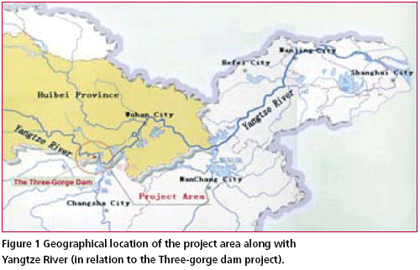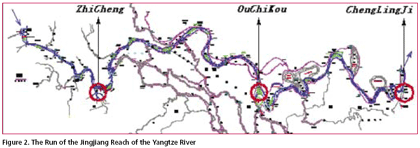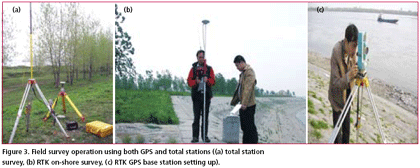| Surveying | |
River cross-section surveying using RTK Technology
|
||||
|
China has a vast expanse of land with intertwining rivers and mountains, abounds in lakes and reservoirs. The survey of rivers and lakes as well as the protection and exploitation of these resources plays an important role in Chinese economy. Cross-section survey of water bodies is a key part in hydrographic engineering survey. Traditional methods of cross section survey of a river such as theodolite intersection, theodolite stadia, electronic distance measurement, depth-surveying bar, leadline, handlead survey and echo sounder are the main methods used for water bathymetry. These methods are not only prone to the inaccuracy of instruments, distances, weather conditions, intervisibility and communication device, but also involved in tedious workload which leads to low efficiency. Some unfavorable factors such as the flow of the water and the nonlinear movement of the surveying ship make measuring the depth of the water more difficult. Lack of skills and cooperation among surveyors might result in a low accuracy in the position fix of cross-section points, thus further affects the quality of cross-section survey of the river. The application of real-time kinematic (RTK) GPS positioning technique has opened a new avenue for the crosssection survey of rivers (Wu, 2005). Simultaneous utilization of RTK GPS technology and the shipboard sounding method (e.g. digital depth sounder) will greatly improve the accuracy and efficiency of cross-sectioning survey of rivers(Qiu and Fong, 2002; Qiu 2004; Zhang et al, 2002). Basic principles of RTK GPSFor high accuracy GPS positioning, “differential” GPS technique is used where one receiver acts as “the base” and the rover is positioned in a close vicinity of the base to take advantage of the nature of spatial correlation of the GPS measurement errors such as atmospheric delay, orbital errors, clock errors and other factors in GPS survey. Carrier phase measurements are taken and unknown integer cycles of the carrier waves (i.e. the integer ambiguities) need to be resolved prior to the baseline solution is computed through a “double-differenced” process. Real-time data processing of the GPS measurements at both base and rover stations will make it possible to obtain the stations’ realtime three-dimensional coordinates with a centimeter level accuracy after a successful initialization process (Hu et al., 2005). In practice, a GPS receiver is set on a base station whose coordinates are precisely known. This GPS receiver is connected with a data transmission mechanism, which transmits the observations and the base station information to (one or more) remote roving receivers. With the GPS signal corrections transmitted in real time from a reference receiver at a known location and the information from four or more visible satellites, a data processing is carried out in real time at the rover station, and the ambiguity resolution, position and accuracy of the rover station is obtained. The critcal requirements of the RTK techniques include: simultaneous measurements from a minimum of two GPS receivers, the separation of the base and rover is less than 10- 20km and an on-the-fly data link. Cross-section survey of river in Jinjiang ReachIntroduction of the ProjectYangtze River is our mother river. Chinese people have been living by the mother river generation by generation happily and benefited greatly. At the same time, people have suffered a lot when serious floods occurred. According to historical records the damage is low along lower reaches, high along upper reaches and most severe along middle reaches where Hubei province is located. Taking 1998 as an example, Hubei Province experienced a heavily flooding year with 66 counties waterlogged, 1.54 million hectares of fertile farmland flooded, and 3.83 billion RMB of properties lost (Lei et al., 2000). Figure 1 shows the middle reaches and lower reaches of the Yangtze River and the geographical location of the survey project area respectively. The portion between ZhiCheng and ChengLingJi of the Yangtze River is named Jingjiang Sector, which is the crucial sector of the middle reaches of the Yangtze River and is 347.2 km long (OuChiKou is considered as the dividing line of the upper Jingjiang stretch and lower Jingjiang stretch respectively). Figure 2 shows the run of the Jingjiang sector. The upper Jingjiang stretch is a slightly curved bifurcated reach, while the lower Jingjiang Reach is a meandered reach. There is an important dike along Yangtze River – the Jingjiang embankment in the north side of the river. During the past several decades, the Yangtze River has silt up and the riverbed has been elevated significantly. As a result, the flood water level of the Yangtze River, similar to Huanghe River, the second biggest river in China, has risen by 1.5 to 2.5 meters along the middle reach. Significant changes have taken place in Jingjiang reach since the extraordinary floods in 1998 and 1999, respectively. The bifurcated reach has seen frequent flow fluctuations of the mainstream, erosion and sand deposition of the shoals. The water level of the Three Gorges Reservoir impoundment reached 135 meters in June 2003 and this led to the release of clear water and scoured in the downstream of the Three Gorges Dam. This made Jingjiang reach threatened by frequent bank failures, and the high risk of Jingjiang flood has not been mitigated. Therefore, to investigate the run of the river along the Jingjiang reach is of paramount importance. To meet the needs of the assessment of potential risk, emergency management, and safety research of shipping and the design of other Yangtz river related engineering projects, river course survey of the Yangtze River along the Jingjiang reach is carried out. The survey system requirementsTwo sets of dual frequency geodetic GPS receivers (Trimble 5700) are used for the survey. The manufacturer’s specification of the receiver is: 10 mm+1ppm (Horizontal) and 20 mm+1ppm (Vertical) for kinematic survey. One receiver is set as a base station with an on-the-fly datalink capability. The other GPS receiver is a rover receiver that is used in the survey ship. A laptop computer, SDH- 1C3D numeral echo sounder and other necessary accessories (e.g. power supply, and other fittings) are used. A survey software package (Hypack), cadastral and topographical plotting software CASS 4.0 are also used. Figure 3 shows some field operation and station setting up of the survey using both GPS and a total station. Cross-section surveyAlong the riverbanks, there is a dense flood protection forest. It would be very labor intensive and resources demanding if the conventional cross sections survey technique is used to carry out the survey, this is particularly true for the control survey to connect the area with n high-order ational control points (Jiang et al., 2001; Zhao, 2005). In this aspect, the adoption of the RTK GPS technology is ideal. First, a preliminary design is conducted to use the existing 1:2000 bathymetric map of the Yangtze River. The crosssection survey lines are designed to be roughly perpendicular to the direction of the river course. The positions of the cross-sections control points are then selected in open fields and monuments are established. Each cross-section usually consists of two cross-section points and one in each side of the river. Finally, the 3-D coordinates (both plane coordinates and height) of the points are surveyed. The three-dimensional coordinates of each cross section line are input into a laptop computer. Appropriate geodetic datum parameters in the laptop computer are chosen priori to the computation of the results and the WGS-84 coordinate system and transverse Mercator projection are used in the survey. The unit of the measurements is meters and the area surveyed is located at geographical position of longitude 111°18’00″E to 111°18’10″E and latitude 22°31’25″N to 22°31’35″N respectively. During GPS survey, a base station needs to be located over a known point and the base station should be chosen in such a way that there is no potential strong disturbance sources such as electromagnetic wave, microwave, high voltage power line disturbance etc to avoid the effects of the GPS signal reception and transmission. Before formal survey commences, known control points need to be checked first so that any transformation parameter mistakes or the data/ parameters errors can be detected and corrected (Huang et al, 2001). Then two points of a cross section line will be measured then their coordinates will be automatically produced in the laptop computer and displayed on the screen. At the same time, the laptop computer will also show the position and station number of the surveyor. So the surveyor may know whether he/she is on the cross section line or not as well as knowing intervals between the stations. The component of the station 3-D coordinates from GPS is also re-surveyed using an Electronic Total Station (ETS) for both confirmation and quality check. |
||||
Pages: 1 2















 (No Ratings Yet)
(No Ratings Yet)




